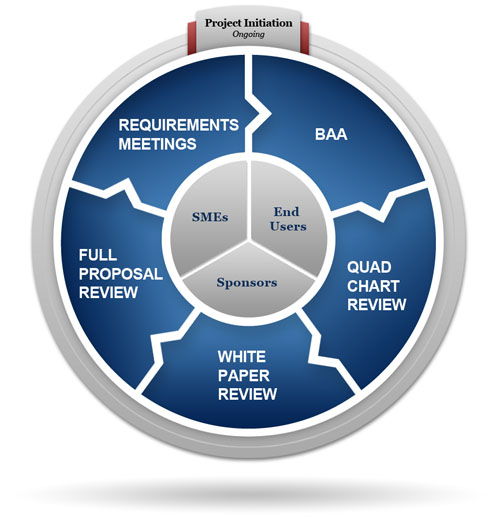The IWTSD business model identifies and prioritizes requirements of the national interagency community including defense as well as international partners through rapid research, development, testing, and evaluation while providing operational support for demonstration and field testing of irregular warfare solutions. This process prioritizes user requirements and program budgets, employs flexible contracting strategies, and leverages funding resources from partnering agencies to enable effective project selection with the best solution for the resources available.
The IWTSD business cycle is a deliberate yet flexible process that meets the needs for rapid prototyping and fielding of technology and equipment in support of the counter irregular warfare mission. Sponsors, end users, and subject matter experts remain engaged throughout the business cycle to ensure that the proposed solution meets the requirement and that the resulting technology and equipment gets in the hands of those who need it.

The IWTSD Business Cycle begins in January by inviting the user/operator communities to annual meetings to discuss and prioritize their operational gaps and needs. Each TSWG Subgroup invites members of their user community to present requirements that, left unfulfilled, hinder their mission effectiveness. Members come prepared to identify, discuss, and fully explain their agency's technology objectives. Discussions among the members center on whether tactics, techniques, and procedures or existing marketplace solutions can effectively mitigate each requirement. Once the user community has constructed acceptable definitions for all requirements, a voting session is conducted to establish a priority for each requirement. The prioritized list is used to assist in establishing a cutoff (down selection) of requirements to be advertised in the Broad Agency Announcement (BAA) for the current business cycle.
Upon completion of requirements meetings and review, the requirements are prepared for Industry Day. The purpose is to provide a forum for open dialogue with potential bidders to ensure that the requirements are clearly stated and understandable by representatives from industry, government labs, and academia, and to provide those representatives with an advanced look at the requirements planned for solicitation. All clarifications, refinements, or corrections determined necessary as a result of Industry Day are incorporated into the finalized requirements prior to generation of the Broad Agency Announcement.
Each year the IWTSD publishes irregular warfare requirements in at least one BAA. All BAAs are available directly from the BAA Information Delivery System (BIDS) homepage immediately after posting. Registration is not required to download the BAA package; however, a BIDS registration is required to upload a response to the BAA. To be eligible for contract award, a responsible offeror must meet certain minimum standards pertaining to financial solvency and resources, ability to comply with the performance schedule, prior record of satisfactory performance, integrity, organization, experience, operational controls, technical skills, facilities, and equipment. See FAR 9.104. Additionally, all offerors must be registered in the System for Award Management (SAM) database, as indicated in FAR 4.1100.
In order to keep the barriers to entry as low as possible, IWTSD employs a three-phased approach for submission, beginning with a preliminary submission of a Quad Chart. Each submission (initially Quad Charts, then White Papers, and Full Proposals) are evaluated on its individual merit and relevance to the program requirement rather than against other proposals in the same general research area.
Phase I Quad Charts are received in April and requires only the development of a one-page (8 1/2 x 11 inches) Quad Chart that highlights notable attributes of the bidder's proposed response to the advertised requirement, including estimates of cost and schedule. If more than one page is submitted, only the first page will be evaluated. All Quad Charts must be received electronically through BIDS.
Phase II White Papers are received in June and requires only those bidders selected during the government evaluation of Phase I to elaborate on the Quad Chart with the preparation of a White Paper limited to 12 pages of text, diagrams, and charts that define specific criteria exposed in the BAA. Evaluations are performed and consolidated into a single recommendation that is submitted and briefed prior to acceptance into the next solicitation phases.
Phase III Full Proposals are received in September and requires only those bidders selected after successful government review of all technical prerequisites. In this phase, bidders are requested to submit full descriptive proposals meeting all final phase requirements in the BAA. Each TSWG Subgroup, assisted by appointed Subgroup Chairs, subject matter experts, and end users, conducts technical review of only those responses directly related to the requirements with their cognizance. Evaluations performed within each mission are again consolidated into a single recommendation that is accepted for contract award and project initiation.
Once a full proposal has been accepted, pending a final favorable review, the action is prepared for contract negotiation. The goal is to award all projects by the beginning of the fiscal year.

